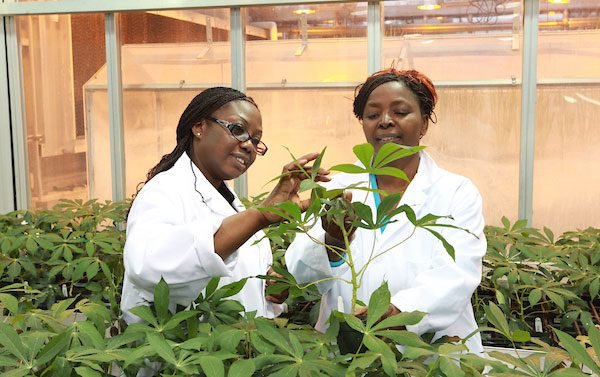Nigerian researchers look to cut off gene feeding cassava disease
“It was an eye-opener. It was the opportunity ofa a lifetime. I was able to gain hands-on experience in microbiology and plant transformation. In addition to the lab experience, I built relationships with scientists throughout the world, some of who are still my collaborators today.
Dr Ihuoma Okwuonu (left) and Irene Njagi (right) examining cassava plants in a greenhouse. Photo Credit: Donald Danforth Plant Science Center.
Nigerian researchers look to cut off gene feeding cassava disease SPECIAL REPORT I wanted to make an impact on the world.
I believed I could make an impact by developing products that will improve the lives of people in Nigeria,” says the plant biotechnologist.
Today, Dr Okwuonu is doing just that. In her role as a chief research scientist at the National Root Crops Research Institute (NRCRI) in Umudike, Nigeria, she is working with researchers on the VIRCA Plus project to develop cassava varieties with elevated levels of iron and zinc to combat micronutrient deficiency.
The VIRCA Plus project is an international collaboration between the Donald Danforth Plant Science Center in St. Louis, MO, the Kenya Agricultural and Livestock Research Organisation (KALRO), the National Agricultural Research Organisation (NARO) in Uganda, National Root Crops Research Institute (NRCRI) in Nigeria, the Rwandan Agriculture Board (RAB), and Mennonite Economic Development Associates (MEDA), with ISAAA AfriCenter and SCIFODE providing communication and policy outreach support.
In Nigeria, 75 percent of preschool children and 67 percent of pregnant women are anaemic, and 20 percent of children below five years suffer from zinc deficiency.
Iron deficiency affects the immune system, stunts growth and impairs cognitive development in children, while deficiency in zinc causes increased risk of death from diarrhoea, stunting and reduced cognitive development.
Dr Okwuonu introduced her colleagues at the Danforth Center to studying gari and fufu, two common West African foods, prepared by chopping, soaking, fermenting, pressing and roasting cassava.
They found that biofortified cassava could provide as much as 40-50 percent of nutritional requirements for iron and 60-70 percent of nutritional requirements for zinc for children and women.
“We are using genome editing for increased understanding of the role of sweet gene in cassava Bacterial Blight Disease (BBD). One of the reasons why we are improving cassava is because of the impact of the disease,” she says.
Once the bacterium attaches itself to a plant cell, it releases its own ammunition in form of proteins that goes inside the cassava cell, forcing the cassava to produce sugar.
This sugar helps the bacteria to grow fast, colonise the plant and cause disease. The gene making cassava prone to the disease is called susceptibility gene. If researchers identify this gene, they can use genome editing tools to cut, remove or manipulate it. “Our goal is to cut off the portion of that gene that enables the bacteria to multiply and grow.” says Dr Okwuonu.
“Our second goal is to use genome editing to develop a disease monitoring tool. We could use the tool to develop a disease model that can help us understand the progression of this disease in cassava. This is a way forward for cassava improvement as things that were initially not possible with conventional breeding are now possible.”


